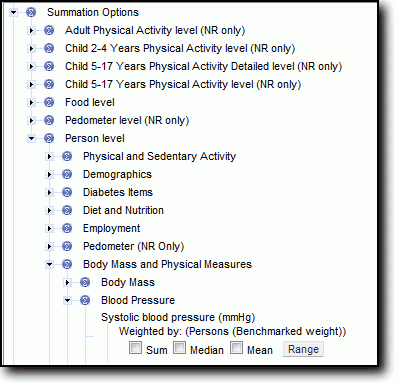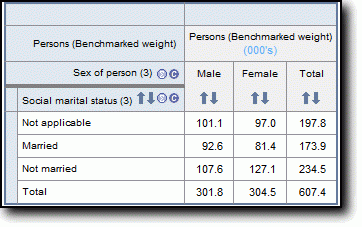In accordance with the Census and Statistics Act 1905, all the data in TableBuilder are subjected to a confidentiality process before release. This confidentiality process is undertaken to avoid releasing information that may allow the identification of particular individuals, families, households, dwellings or businesses.
Processes used in TableBuilder to confidentialise records include the following:
- perturbation of data
- table suppression
- field exclusion groups
Perturbation effects
To minimise the risk of identifying individuals in aggregate statistics, a technique is used to randomly adjust cell values. This technique is called perturbation. Perturbation involves small random adjustments of the statistics and is considered the most satisfactory technique for avoiding the release of identifiable statistics while maximising the range of information that can be released. These adjustments have a negligible impact on the underlying pattern of the statistics.
The introduction of these random adjustments result in tables not adding up. While some datasets apply a technique called additivity to give internally consistent results, additivity has not been implemented on this TableBuilder. As a result, randomly adjusted individual cells will be consistent across tables, but the totals in any table will not be the sum of the individual cell values. The size of the difference between summed cells and the relevant total will generally be very small.
Please be aware that the effects of perturbing the data may result in components being larger than their totals. This includes determining proportions.
Table suppression
Some tables generated within TableBuilder may contain a substantial proportion of very low counts within cells (excluding cells that have counts of zero). When this occurs, all values within the table are suppressed in order to preserve confidentiality. The following error message below is displayed at the bottom of the table when table suppression has occurred.
ERROR: The table has been suppressed as it is too sparse
ERROR: table cell values have been suppressed
Field exclusion rules
Certain groups of similar variables are restricted from being used together in a table. These restrictions are referred to as field exclusion rules, and are in place in order to protect confidentiality. The collections of similar variables restricted in this way are called field exclusion groups.
For the Australian Aboriginal and Torres Strait Islander Health Survey there is one field exclusion group. This consists of the 2011 geographical and Socio-Economic Indexes for Areas (SEIFA) data items (see below for items).
Only one data item from this group may be used in a single table.
The geographic exception to this is the State or Territory item, which can be used in addition to one item from this group.
Items included in the field exclusion group are:
2011 Geographic Items
- Remoteness area categories ASGS 2011
- Greater Capital City Statistical Areas ASGS 2011
- Section of state ASGS 2011
- Primary Health Network 2011
2011 SEIFA Items
- Index of Economic Resources - 2011 - SA1 - Deciles - National
- Index of Economic Resources - 2011 - SA1 - Deciles - State
- Index of Economic Resources - 2011 - SA2 - Deciles - National
- Index of Economic Resources - 2011 - SA2 - Deciles - State
- Index of Education and Occupation - 2011 - SA1 - Deciles - National
- Index of Education and Occupation - 2011 - SA1 - Deciles - State
- Index of Education and Occupation - 2011 - SA2 - Deciles - National
- Index of Education and Occupation - 2011 - SA2 - Deciles - State
- Index of Relative Socio-economic Advantage and Disadvantage - 2011 - SA1 - Deciles - National
- Index of Relative Socio-economic Advantage and Disadvantage - 2011 - SA1 - Deciles - State
- Index of Relative Socio-economic Advantage and Disadvantage - 2011 - SA2 - Deciles - National
- Index of Relative Socio-economic Advantage and Disadvantage - 2011 - SA2 - Deciles - State
- Index of Relative Socio-economic Disadvantage - 2011 - SA1 - Deciles - National
- Index of Relative Socio-economic Disadvantage - 2011 - SA1 - Deciles - State
- Index of Relative Socio-economic Disadvantage - 2011 - SA2 - Deciles - National
- Index of Relative Socio-economic Disadvantage - 2011 - SA2 - Deciles - State









